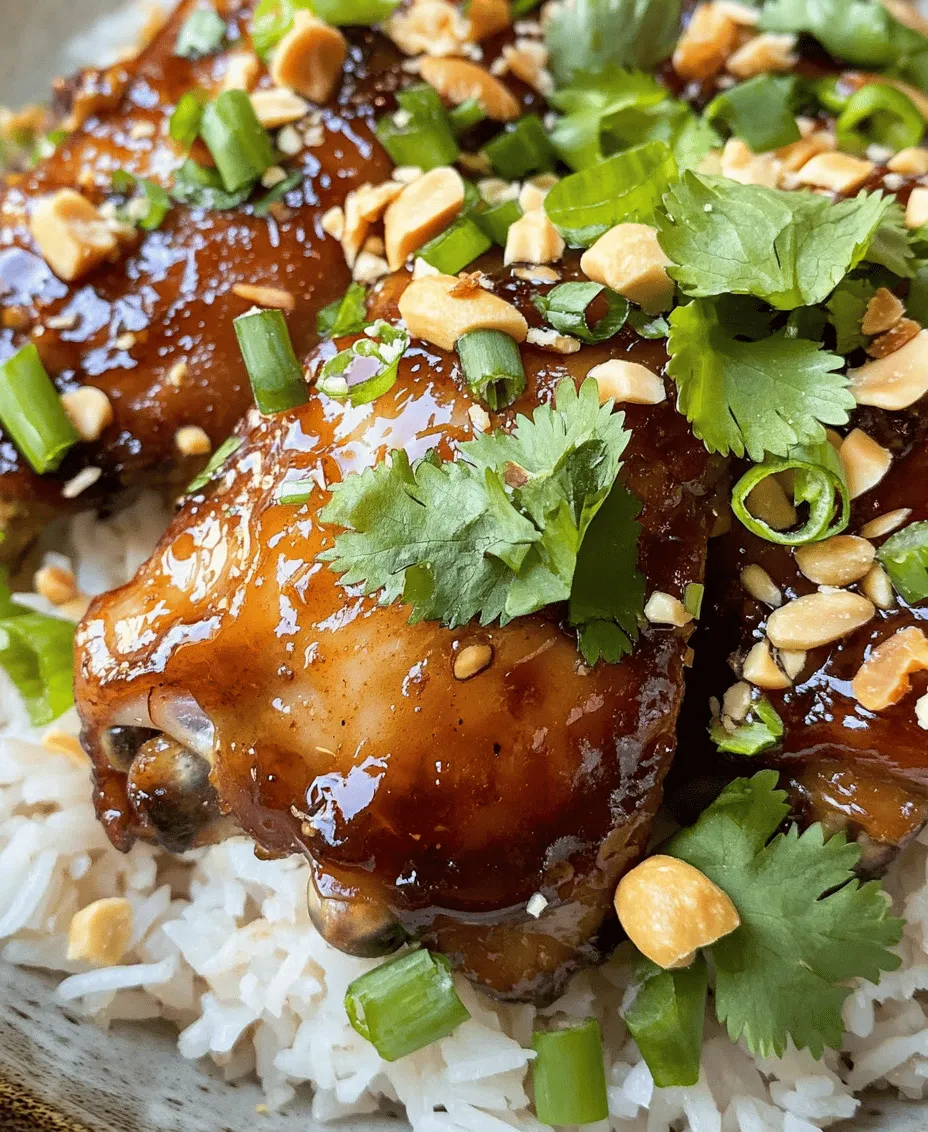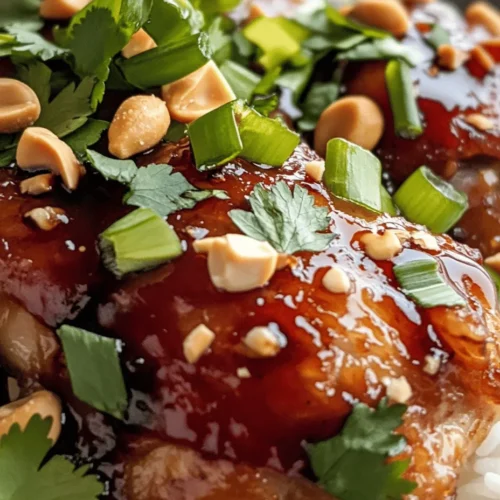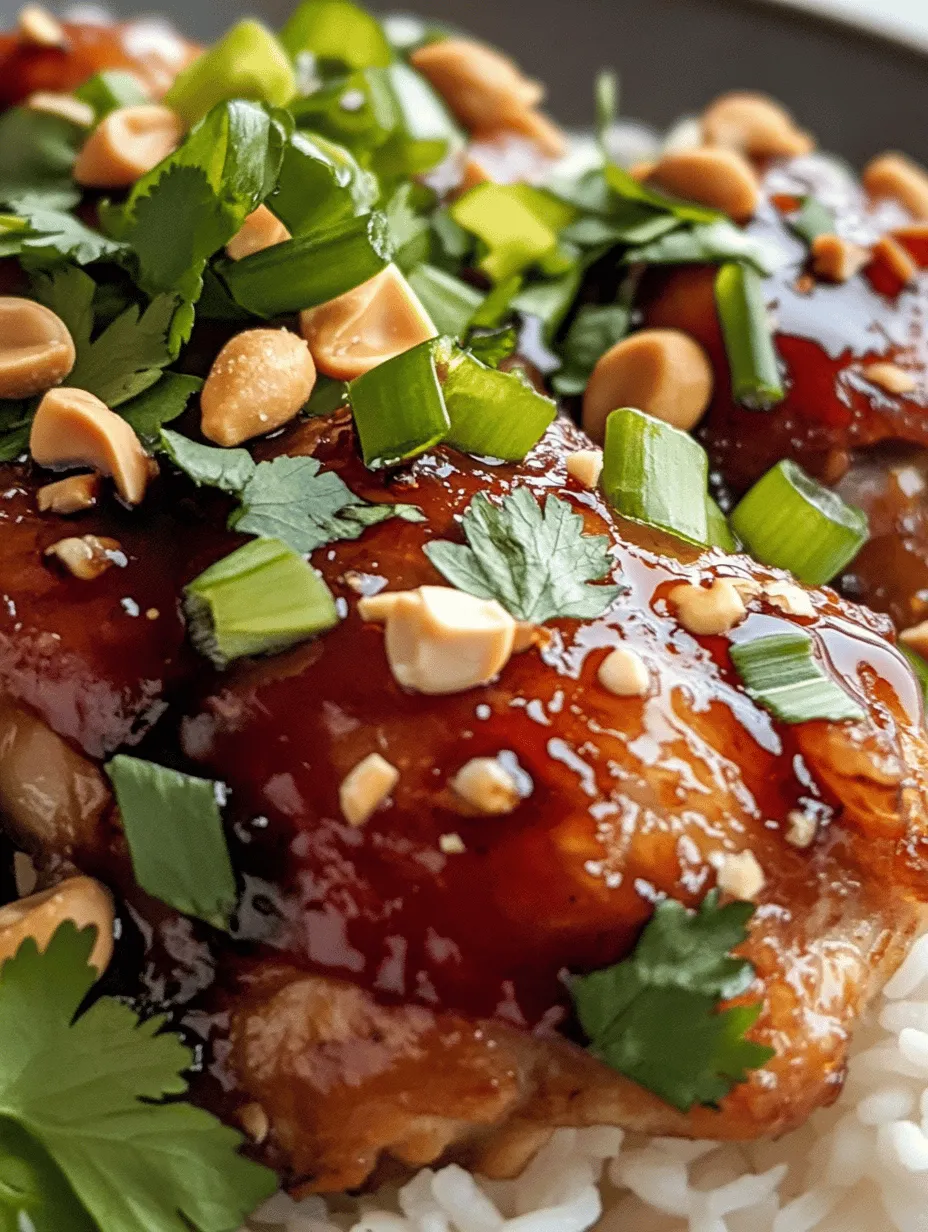Introduction
Thai cuisine has captivated the hearts and taste buds of food lovers around the world. Known for its vibrant flavors and aromatic ingredients, it has made a significant mark in the culinary scene. From the bustling street food stalls of Bangkok to high-end restaurants, Thai dishes are celebrated for their balance of sweet, salty, sour, and spicy elements. Among the vast array of Thai recipes, Sweet & Spicy Thai Chicken stands out as a quintessential representation of this intricate flavor balance.
This delightful dish fuses the rich, savory taste of chicken with a harmonious blend of sweetness from honey and a gentle kick of heat from spices, making it an ideal choice for various occasions. Whether you’re looking to impress guests at a dinner party or simply want to enjoy a comforting meal at home, Sweet & Spicy Thai Chicken offers a versatile option that can be easily adapted to suit your preferences.
Understanding the Flavors of Thai Cuisine
To truly appreciate the Sweet & Spicy Thai Chicken, it’s essential to understand the foundational elements of Thai cooking. The essence of Thai cuisine lies in its ability to achieve a delicate balance among four primary taste profiles: sweet, salty, sour, and spicy.
Common Ingredients in Thai Cooking
Thai dishes often incorporate a variety of fresh ingredients that contribute to this balance. You will frequently find staples such as:
– Fresh herbs: Thai basil, cilantro, and mint lend aromatic qualities and freshness.
– Spices: Ingredients like lemongrass, galangal, and kaffir lime leaves provide depth and complexity to dishes.
– Sauces: Fish sauce, soy sauce, and oyster sauce add umami and saltiness, enhancing the overall flavor profile.
– Fruits and Vegetables: From vibrant chilies to juicy limes, these components offer not only flavor but also visual appeal.
The Sweet & Spicy Thai Chicken recipe showcases many of these traditional ingredients, creating a dish that embodies the core characteristics of Thai cuisine.
The Role of Sweet, Salty, Sour, and Spicy Elements
Balancing these tastes is crucial in Thai cooking. For instance, the sweetness in a dish can soften the impact of spiciness, while acidity can cut through richness and enhance flavors. This intricate dance of flavors is what makes Thai food so exciting and satisfying.
In the case of Sweet & Spicy Thai Chicken, the interplay between honey’s sweetness and the heat from various spices creates a dynamic flavor experience. This dish not only tantalizes your taste buds but also reflects the heart of Thai culinary philosophy—harmony.
Ingredients Breakdown
Now that we’ve set the stage, let’s dive into the specific ingredients that make up the Sweet & Spicy Thai Chicken. Each element plays a vital role in crafting the dish, contributing unique flavors and textures.
Boneless, Skinless Chicken Thighs
Boneless, skinless chicken thighs are the star of this recipe. They are preferred over chicken breasts for several reasons. Firstly, thighs have a higher fat content, which results in a juicier and more flavorful end product. Secondly, they are less likely to dry out during cooking, making them forgiving for those who may not be expert cooks. Their rich flavor serves as a perfect canvas for the marinade and spices.
Soy Sauce
Soy sauce is a staple in many Asian cuisines, and in this recipe, it contributes a significant umami flavor. The saltiness of soy sauce also helps to enhance the overall taste of the chicken, ensuring that each bite is packed with flavor. Additionally, it aids in tenderizing the meat, making for a more succulent dish.
Honey
Honey adds a natural sweetness that beautifully balances the spiciness of the dish. Beyond its flavor, honey is also known for its health benefits, including its antioxidant properties and ability to soothe sore throats. In this recipe, honey not only sweetens the chicken but also helps in caramelizing the meat during cooking, resulting in a beautiful glaze.
Fish Sauce
Fish sauce is another key ingredient in Thai cuisine, providing a depth of flavor that is hard to replicate with other sauces. Made from fermented fish, it adds a savory note that enhances the overall complexity of the dish. A little goes a long way, so it’s important to use it judiciously to avoid overpowering the other flavors.
Lime Juice
Lime juice is crucial for adding acidity to the Sweet & Spicy Thai Chicken. Its bright and tangy flavor cuts through the richness of the chicken and balances the sweetness of the honey. Furthermore, lime juice aids in marinating the chicken, helping to tenderize the meat while infusing it with flavor.
Red Curry Paste
Red curry paste is a powerhouse of flavor, bringing heat and complexity to the dish. Typically made from a blend of red chilies, garlic, lemongrass, galangal, and spices, it introduces a warm spiciness and aromatic quality that is characteristic of many Thai dishes. Depending on your spice tolerance, you can adjust the amount used to customize the heat level.
Garlic and Ginger
Garlic and ginger are essential aromatics in Thai cooking. They not only enhance the flavor but also offer numerous health benefits, including anti-inflammatory properties and digestive support. Their robust flavors complement the other ingredients, adding layers of taste to the marinade.
Chili Flakes
To further elevate the spice level, chili flakes can be added according to personal preference. They allow for customization, ensuring that everyone can enjoy the dish at their desired heat level. Whether you like it mild or fiery, adjusting the chili flakes is an easy way to tailor the recipe.
Garnishes
Finally, garnishes such as cilantro, green onions, and crushed peanuts are essential for adding texture and freshness to the dish. Cilantro and green onions provide a pop of color and aromatic qualities, while peanuts add a delightful crunch, creating a multi-dimensional eating experience.
Marinating the Chicken
Marinating the chicken is a crucial step in the Sweet & Spicy Thai Chicken recipe. This process not only enhances the flavor but also helps to tenderize the meat, allowing it to soak up all the delicious components of the marinade.
Importance of Marinating for Flavor Enhancement
By allowing the chicken to marinate, you are essentially infusing it with the flavors of the soy sauce, honey, fish sauce, lime juice, and spices. This results in a chicken dish that is bursting with flavor from the inside out. A well-marinated chicken will taste far more delicious than one that is simply seasoned right before cooking.
Step-by-Step Guide on How to Prepare the Marinade
1. Combine the Ingredients: In a mixing bowl, combine the soy sauce, honey, fish sauce, lime juice, red curry paste, minced garlic, minced ginger, and chili flakes.
2. Whisk Until Smooth: Use a whisk to blend the ingredients together until smooth and well combined.
3. Prepare the Chicken: Place the boneless, skinless chicken thighs in a resealable plastic bag or a shallow dish.
4. Add the Marinade: Pour the marinade over the chicken, ensuring that each piece is thoroughly coated.
5. Seal and Refrigerate: If using a bag, seal it tightly, pressing out any excess air. If using a dish, cover it with plastic wrap. Refrigerate for at least 30 minutes, but ideally for 2-4 hours for optimal flavor penetration.
Tips for Achieving the Best Marination Results
– Use Fresh Ingredients: Fresh herbs and spices yield the best flavors, so be sure to use fresh garlic and ginger instead of dried.
– Marinate Longer for More Flavor: If time permits, marinating the chicken overnight can greatly enhance the flavor.
– Keep it Cool: Always marinate in the refrigerator to prevent bacterial growth, especially if marinating for extended periods.
By following these steps, you will ensure that your Sweet & Spicy Thai Chicken is not only flavorful but also tender and juicy, ready to be cooked to perfection.
With this detailed introduction and breakdown of ingredients and marination, you’re well on your way to discovering the delightful world of Sweet & Spicy Thai Chicken. Stay tuned as we explore the cooking techniques and tips that will help you bring this vibrant dish to your table!

Searing the Chicken
Searing chicken is a critical step that enhances flavor and texture, creating a delicious contrast between the crispy exterior and juicy interior. When preparing Sweet & Spicy Thai Chicken, the ideal cut is boneless, skinless chicken thighs, known for their rich flavor and tenderness.
To achieve optimal results, heat a large skillet over medium-high heat until it’s hot enough that a drop of water sizzles upon contact. The key to perfect searing is ensuring the chicken is dry before placing it in the pan. Pat the chicken thighs with paper towels to absorb excess moisture, which helps in forming that coveted golden-brown crust.
Cook the chicken thighs for 5-7 minutes on one side without moving them, allowing the Maillard reaction to occur, which creates that beautiful crust. Flip the chicken and reduce the heat to medium, cooking for another 5-7 minutes, or until the internal temperature reaches 165°F (75°C). This temperature ensures the chicken is fully cooked yet retains its juiciness. If you overcook the chicken, it can become dry and tough, so using a meat thermometer is highly recommended.
Creating the Glaze
The marinade used in this recipe does more than flavor the chicken; it transforms into a rich glaze when cooked down properly. The sweetness from the honey combined with the heat from the chili flakes creates a tantalizing sauce that clings perfectly to the chicken.
To create the glaze, remove the seared chicken from the skillet and set it aside. In the same skillet, pour in the reserved marinade, scraping up any browned bits left from the chicken. This process, known as deglazing, adds depth and complexity to your sauce. Allow the marinade to simmer for about 5-10 minutes over medium heat, stirring occasionally until it thickens.
To achieve the perfect consistency, you may add a cornstarch slurry (1 tablespoon of cornstarch mixed with 2 tablespoons of cold water) to the simmering sauce, stirring until it thickens further. The glaze should coat the back of a spoon; if it’s too thick, add a splash of water or chicken broth to reach your desired consistency.
Coating and Serving the Chicken
Once the glaze has thickened, return the chicken to the skillet and toss it gently to ensure each piece is evenly coated. This step is essential for a uniform flavor profile, allowing the sweet and spicy sauce to envelop the chicken entirely.
For an appealing presentation, serve the Sweet & Spicy Thai Chicken over a bed of fluffy jasmine rice or rice noodles, which complement the dish beautifully. Jasmine rice is fragrant and sticky, making it perfect for soaking up the flavorful glaze, while rice noodles add a delightful texture.
To elevate your dish visually, consider garnishing with sliced green onions, chopped cilantro, or crushed peanuts. These toppings not only add a pop of color but also enhance the dish’s flavor profile. A squeeze of fresh lime juice over the top can provide a refreshing contrast to the sweetness of the glaze.
Nutritional Information
Understanding the nutritional profile of Sweet & Spicy Thai Chicken can help you enjoy this dish more mindfully. This recipe offers a well-rounded balance of protein, healthy fats, and carbohydrates, making it a satisfying meal option.
A serving of Sweet & Spicy Thai Chicken typically contains approximately 280 calories, 25 grams of protein, 10 grams of fat, and 20 grams of carbohydrates. The chicken thighs provide a rich source of protein and iron, while the honey offers natural sweetness along with antioxidants. The inclusion of fresh ingredients such as ginger and garlic contributes additional health benefits, including anti-inflammatory properties and immune support.
When enjoying this dish, it’s essential to practice portion control. Pairing the chicken with a generous serving of vegetables, such as steamed broccoli or stir-fried bell peppers, can enhance the nutritional value of your meal while making it more filling.
Cultural Significance of Thai Dishes
Thai cuisine is renowned for its complex flavors and vibrant colors, reflecting the country’s rich cultural heritage. Historically, Thai food is influenced by various cultures, including Chinese, Indian, and Malay, leading to its distinctive combination of sweet, sour, salty, and spicy flavors.
Food plays an integral role in Thai culture, not only as a means of sustenance but also as a way to foster community and familial bonds. Meals are often shared among family and friends, emphasizing the importance of togetherness. Festivals and special occasions are celebrated with elaborate feasts, showcasing the abundance and diversity of Thai culinary traditions.
In Thai culture, cooking is considered an art form, and each dish tells a story. Sweet & Spicy Thai Chicken embodies this philosophy, as it harmonizes contrasting flavors, creating a dish that is both comforting and exciting. Exploring Thai cuisine allows you to appreciate the balance of flavors and the joy of sharing meals with loved ones.
Conclusion
The Sweet & Spicy Thai Chicken recipe is a delightful culinary journey that brings together vibrant flavors and aromatic spices. From the searing process that locks in moisture and creates a crispy exterior to the flavorful glaze that adds a perfect finish, each step contributes to the overall experience of this dish.
By serving the chicken with jasmine rice or rice noodles and garnishing it with fresh herbs, you create not only a meal but a feast that reflects the joy of cooking and sharing food. As you explore this recipe, consider delving deeper into the world of Thai cuisine—where every dish offers a new adventure filled with rich history and communal love.
Embrace the process of cooking, enjoy the aromatic results, and share this sweet and spicy delight with your loved ones, creating memories that will last a lifetime.



